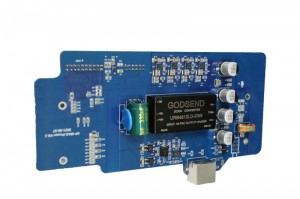PCBA ke khutsufatso ea Printed Circuit Board Assembly ka Senyesemane, ke ho re, boto ea PCB e se nang letho e feta karolong e ka holimo ea SMT, kapa tšebetso eohle ea plug-in ea DIP, e bitsoang PCBA.Ona ke mokhoa o sebelisoang hangata Chaena, athe mokhoa o tloaelehileng Europe le Amerika ke PCB' A, eketsa "'", e bitsoang maele a molao.
E hatisitsoeng oa potoloho boto, eo hape e tsejoang e le e hatisitsoeng oa potoloho boto, hatisitsoeng oa potoloho boto, hangata e sebelisa Senyesemane khutsufatso PCB (Printed potoloho boto), ke karolo ea bohlokoa ea elektronike, tšehetso bakeng sa likarolo tsa elektronike, 'me mofani wa dikgokelo wa potoloho bakeng sa likarolo tsa elektronike.Hobane e entsoe ka mekhoa ea khatiso ea elektronike, e bitsoa "boto ea potoloho" e hatisitsoeng.Pele ho hlaha ha liboto tsa potoloho tse hatisitsoeng, ho hokahanngoa pakeng tsa likarolo tsa elektronike ho itšetlehile ka ho hokahanya ha lithapo ho etsa potoloho e feletseng.Hona joale, phanele ea potoloho e teng feela e le sesebelisoa se sebetsang sa liteko, 'me boto ea potoloho e hatisitsoeng e fetohile boemo bo ka sehloohong indastering ea lisebelisoa tsa elektroniki.Qalong ea lekholo la bo20 la lilemo, e le ho nolofatsa tlhahiso ea mechine ea elektronike, ho fokotsa khoele pakeng tsa likarolo tsa elektronike, le ho fokotsa litšenyehelo tsa tlhahiso, batho ba ile ba qala ho ithuta mokhoa oa ho fetola mohala ka khatiso.Lilemong tse 30 tse fetileng, lienjineri li 'nile tsa etsa tlhahiso ea ho eketsa li-conductors tsa tšepe holim'a li-insulating substrates bakeng sa wiring.E atlehileng ka ho fetisisa e bile ka 1925, Charles Ducas oa United States o ile a hatisa mekhoa ea potoloho holim'a li-insulating substrates, 'me a atleha ho theha li-conductor bakeng sa lithapo ka electroplating.
Ho fihlela 1936, Paul Eisler oa Austria (Paul Eisler) o ile a hatisa theknoloji ea filimi ea foil United Kingdom.O ile a sebelisa boto ea potoloho e hatisitsoeng mochineng oa seea-le-moea;E ile ea sebelisoa ka katleho bakeng sa patent bakeng sa mokhoa oa ho foka le ho kenya mohala (Patent No. 119384).Har'a tse peli, mokhoa oa Paul Eisler o tšoana haholo le liboto tsa potoloho tse hatisitsoeng kajeno.Mokhoa ona o bitsoa mokhoa oa ho tlosa, e leng ho tlosa tšepe e sa hlokahaleng;ha mokhoa oa Charles Ducas le Miyamoto Kinosuke ke ho eketsa tšepe e hlokahalang feela.Wiring e bitsoa mokhoa oa ho eketsa.Leha ho le joalo, hobane likarolo tsa elektronike ka nako eo li ne li hlahisa mocheso o mongata, li-substrates tse peli li ne li le thata ho li sebelisa hammoho, kahoo ho ne ho se na mokhoa o sebetsang o sebetsang, empa hape o ile oa etsa hore theknoloji ea potoloho e hatisitsoeng e tsoele pele.
Histori
Ka 1941, United States e ile ea penta pente ea koporo holim'a talc bakeng sa likhoele ho etsa li-fuse tsa proximity.
Ka 1943, Maamerika a ile a sebelisa theknoloji ena haholo liea-le-moeeng tsa sesole.
Ka 1947, li-resin tsa epoxy li ile tsa qala ho sebelisoa e le li-substrates tsa tlhahiso.Ka nako e ts'oanang, NBS e ile ea qala ho ithuta mahlale a tlhahiso a joalo ka li-coil, capacitor, le li-resistors tse entsoeng ke theknoloji ea potoloho e hatisitsoeng.
Ka 1948, United States e ile ea amohela ka molao boqapi boo bakeng sa tšebeliso ea khoebo.
Ho tloha ka bo-1950, li-transistors tse nang le mocheso o tlase oa mocheso li nkile sebaka sa li-vacuum tubes, 'me theknoloji ea boto ea potoloho e hatisitsoeng e se e qalile ho sebelisoa haholo.Ka nako eo, theknoloji ea etching foil e ne e le eona ntho e ka sehloohong.
Ka 1950, Japane e ile ea sebelisa pente ea silevera bakeng sa ho kenya likhoele holim’a litšepe tsa khalase;le foil ea koporo bakeng sa likhoele holim'a li-phenolic substrates (CCL) tse entsoeng ka resin ea phenolic.
Ka 1951, ponahalo ea polyimide e ile ea etsa hore ho hanyetsa mocheso oa resin ho tsoele pele, 'me li-substrates tsa polyimide li ile tsa boela tsa etsoa.
Ka 1953, Motorola e ile ea qapa mokhoa o nang le mahlakore a mabeli a nang le mahlakore a mabeli.Mokhoa ona o boetse o sebelisoa ho liboto tsa potoloho tsa mekhahlelo e mengata hamorao.
Lilemong tsa bo-1960, ka mor'a hore boto ea potoloho e hatisitsoeng e sebelisoe haholo ka lilemo tse 10, theknoloji ea eona e ile ea hōla le ho feta.Ho tloha ha boto e nang le mahlakoreng a mabeli ea Motorola e tsoa, liboto tsa potoloho tse hatisitsoeng tsa multilayer li ile tsa qala ho hlaha, tse ileng tsa eketsa karo-karolelano ea wiring ho substrate area.
Ka 1960, V. Dahlgreen o ile a etsa boto ea potoloho e hatisitsoeng e feto-fetohang ka ho maneha filimi ea tšepe ea tšepe e hatisitsoeng ka potoloho ka polasetiki ea thermoplastic.
Ka 1961, Mokhatlo oa Hazeltine oa United States o ile oa bua ka mokhoa oa electroplating through-hole ho hlahisa mapolanka a mangata.
Ka 1967, "Theknoloji ea Plated-up", e leng e 'ngoe ea mekhoa ea ho haha lera, e ile ea hatisoa.
Ka 1969, FD-R e ile ea etsa liboto tsa potoloho tse hatisitsoeng tse bonolo tse nang le polyimide.
Ka 1979, Pactel o ile a hatisa "Mokhoa oa Pactel", e 'ngoe ea mekhoa ea ho eketsa lera.
Ka 1984, NTT e ile ea theha "Copper Polyimide Method" bakeng sa lipotoloho tse tšesaane tsa lifilimi.
Ka 1988, Siemens e ile ea theha boto ea potoloho e hatisitsoeng ea Microwiring Substrate.
Ka 1990, IBM e ile ea theha "Surface Laminar Circuit" (Surface Laminar Circuit, SLC) e hahang boto ea potoloho e hatisitsoeng.
Ka 1995, Matsushita Electric e ile ea theha boto ea potoloho e hatisitsoeng ea ALIVH.
Ka 1996, Toshiba o ile a theha boto ea potoloho e hatisitsoeng ea B2it.
Nako ea poso: Feb-24-2023

